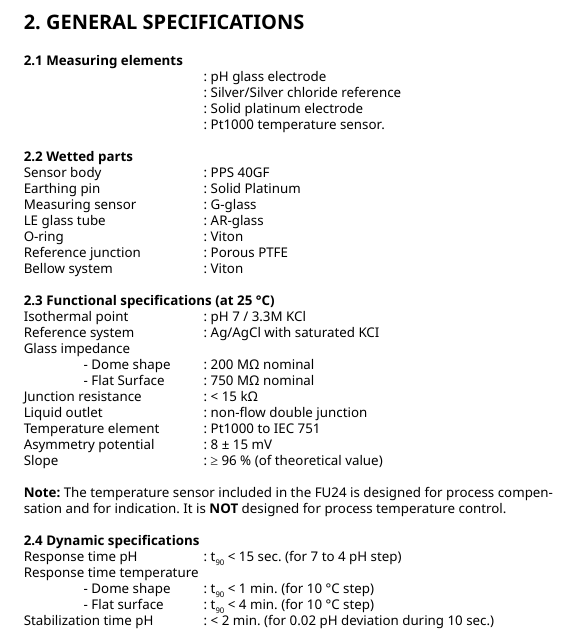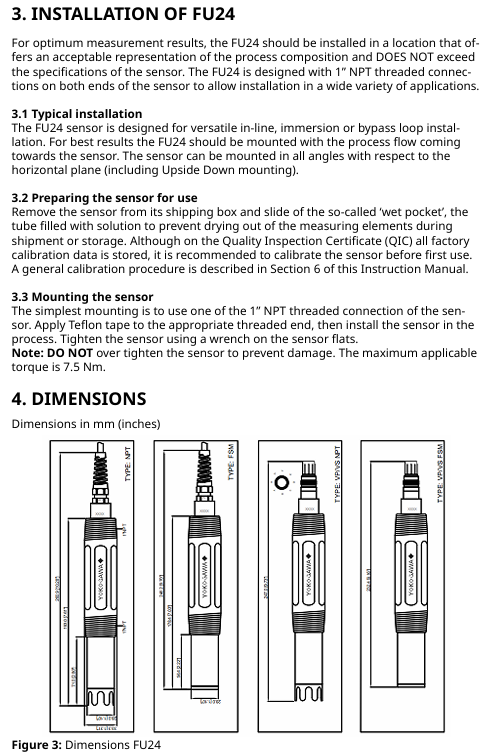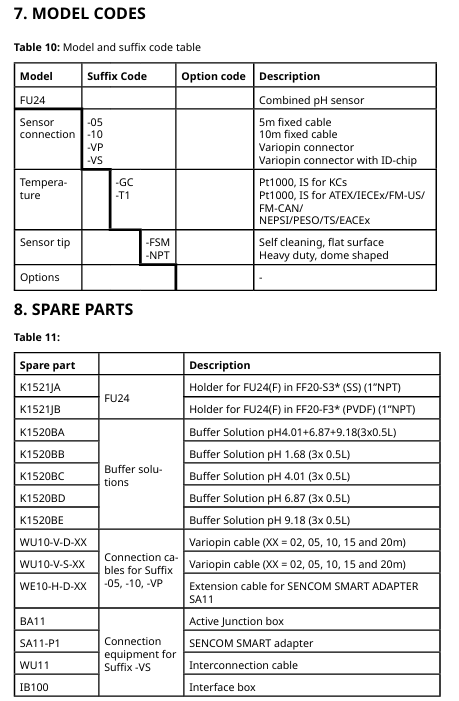

K-WANG


YOKOGAWA FU24 pH/ORP Composite Sensor with Pressure Compensation (IM 12B06J03-03EN-P)
YOKOGAWA FU24 pH/ORP Composite Sensor with Pressure Compensation (IM 12B06J03-03EN-P)
Product positioning and core features
1. Core positioning
FU24 is a composite sensor that integrates pH, ORP (oxidation-reduction potential), rH (relative hydrogen activity), and temperature measurements. It uses a patented bellows system to achieve pressure compensation and maintain stable measurement in pressure fluctuation environments. It also supports full angle safety (including inversion) and is suitable for harsh industrial scenarios.
2. Core advantages
Pressure compensation: The patented bellows system can balance the internal and external pressures in real time, avoiding the impact of process pressure fluctuations on sensor life. It supports 0-10 bar (gauge pressure) and -0.99 bar (negative pressure), and there is no risk of liquid leakage during sudden pressure changes;
Multi parameter integration: achieve pH (0-14), ORP (-1500~+1500 mV), rH (0-100), and temperature (-10~105 ℃) measurement in a single installation, reducing installation space and cost;
Durable design: The main material is PPS 40GF (glass fiber reinforced polyphenylene sulfide), which is resistant to chemical corrosion; The measuring end adopts G-type glass (pH electrode) and AR type glass (reference tube), suitable for various harsh media;
Explosion proof safety: certified by multiple national explosion prevention certifications such as ATEX, IECEx, FM, NEPSI, etc., intrinsic safety type (Ex ia IIC T3~T6 Ga), can be used in hazardous areas such as Class I Div.1/Zone 0;
Intelligent adaptation: We offer models with fixed cables (5m/10m) or Vario Pin connectors (VP without ID chip/VS with ID chip). The VS model can be paired with the SA11-P1 intelligent adapter for data storage and quick replacement.

Detailed explanation of technical specifications
1. Basic measurement parameters
Parameter category specification details
The pH measurement range is 0-14 pH, the asymmetric potential is 8 ± 15 mV, the slope is ≥ 96% of the theoretical value (25 ℃), and the response time t ₉₀<15 seconds (pH 7 → 4 step);
ORP/rH measurement ORP range -1500~+1500 mV, rH range 0~100, using solid platinum electrode, reference system is Ag/AgCl (3.3M KCl);
Temperature measurement with built-in Pt1000 sensor (compliant with IEC 751), dome type -10~105 ℃ (response time t ₉₀<1 minute), flat type 15~105 ℃ (response time t ₉₀<4 minutes);
Environmental adaptability protection level IP67, process temperature -10~105 ℃ (dome type), 15~105 ℃ (flat type), medium conductivity needs to be greater than 10 μ S/cm;
The main material of the mechanical performance is PPS 40GF, and the contact medium components include Viton (O-ring/bellows), PTFE (reference junction), and platinum (grounding pin); The maximum tightening torque is 7.5 Nm, and the interface is a 1-inch NPT thread;
2. Explosion proof and compliance certification
FU24 has passed the global multi regional explosion-proof and safety certification, with the following core certification parameters:
Certification standard explosion-proof level key parameters applicable areas
ATEX/IECEx Ex ia IIC T3~T6 Ga Ui=18 VDC, Ii=170 mA, Pi=400 mW EU and IECEx member states
FM (US/Canada) Class I Div.1/Zone 0, Ex ia IIC Temperature Class T3 (-40~105 ℃)~T6 (-40~40 ℃) US, Canada
NEPSI (China) Ex ia IIC T3~T6 Ga Certificate No. GYJ21.2891X China
Other certifications PESO (India), KCs (South Korea), EAC Ex (Russia) based on ATEX/IECEx certification endorsement for India, South Korea, Russia, etc
3. Model classification
According to the differences in connection methods and functions, FU24 is divided into the following models, with clear suffix code meanings:
Core characteristics of model suffix classification
FU24-05/-10 fixed cable type cable length 5m/10m, directly connected to transmitter (such as FLX21/PH202S series), without ID chip;
FU24-VP Vario Pin 8-pin connector without ID chip, requires WU10/WE10 cable to connect analog transmitter, without sensor information storage function;
FU24-VS Vario Pin with ID chip 8-pin connector (including ID chip), can be paired with SA11-P1 smart adapter, stores sensor calibration data, supports hot swapping;
Suffix - T1/- GC temperature sensor and region-T1: Pt1000, compatible with global certifications such as ATEX/FM/NEPSI; -GC: Compatible with Korean KCs certification;
Suffix - NPT/- FSM measuring end type - NPT: dome type (wear-resistant, suitable for media containing particles); -FSM: Flat type (self-cleaning, suitable for viscous media);
Installation and wiring process
1. Installation preparation
(1) Site selection requirements
Ensure that the measurement points represent the true state of the process medium, avoiding dead zones, bubble accumulation, or low flow rates (recommended flow rate of 0.1~1 m/s);
The ambient temperature should meet the explosion-proof level requirements (such as T6 level -40~40 ℃, T3 level -40~105 ℃), and avoid direct sunlight or severe vibration;
If the conductivity of the medium is greater than 10 μ S/cm, an electrolyte (such as KCl) needs to be added to ensure measurement stability.
(2) Pre installation inspection
After unpacking, confirm that the sensor model and serial number are consistent with the order, check that the cables/connectors are not damaged, and that the measuring end's "wet pocket" (transport protective fluid) is intact;
Remove the 'wet pocket' and rinse the measuring end with deionized water to avoid residual protective solution affecting the measurement; It is recommended to recalibrate before first use (factory calibration data can be found in the QIC certificate).
2. Installation steps
(1) Installation method
Support pipeline installation, immersion installation, and bypass circuit installation. The core steps are as follows:
Thread sealing: Wrap polytetrafluoroethylene tape around the 1-inch NPT thread end (to avoid covering the thread end and prevent contamination of the medium);
Fixed sensor: Use a wrench to clamp onto the flat surface of the sensor body and tighten with a maximum torque of 7.5 Nm to avoid over tightening and damaging the threads;
Angle adaptation: It can be installed at any angle (including inversion), and it is recommended that the medium flow direction be towards the measuring end to reduce bubble adhesion.
(2) Wiring specifications
According to the differences in models, the wiring methods are divided into two categories: fixed cables and Vario Pin connectors:
Wiring Type Wiring Requirements
Fixed cable - brown (core wire): pH signal;
-Brown (shielding layer): pH shielding;
-Black: reference electrode;
-Yellow: LE/ORP signal;
-Red/Blue: Pt1000 temperature sensor;
-The shielding layer needs to be grounded at one end (transmitter side) to avoid interference;
Vario Pin Connector - VP Type (No ID Chip): 8-pin interface, A-pH, B-reference, C-pH shielded D-LE/ORP、E/F-Pt1000;
-VS type (with ID chip): additional G-ID chip power supply, H-ID chip data, requires SA11-P1 adapter;

Calibration and maintenance
1. Calibration process
(1) PH calibration (two-point calibration method)
IEC standard buffer solutions (pH 4.01, 6.87, 9.18) are required, and the steps are as follows:
Cleaning the sensor: Soak it in a 5% hydrochloric acid solution for 5 minutes to remove surface dirt, and then rinse it clean with deionized water;
The first point of calibration: immerse the sensor in pH 6.87 buffer solution, wait for the reading to stabilize, and then perform "zero calibration" according to the transmitter manual;
Second point calibration: Select a buffer solution based on the pH range of the process (4.01 for acidity and 9.18 for alkalinity), repeat step 2 to perform "slope calibration";
Verification and reset: After calibration, rinse with deionized water and immerse in buffer solution again to verify that the error is ≤ 0.02 pH. After confirmation, reinstall the process pipeline.
(2) ORP/rH calibration
Use Chinhydron standard solution (1g/200mL buffer), core steps:
Choose a buffer solution with a pH close to the process pH (such as pH 4.01 or 6.87), dissolve the quinone hydroquinone powder until saturated;
Immerse the sensor in a standard solution, wait for the reading to stabilize, and manually input the theoretical value according to the transmitter manual (such as ORP=96 mV, rH=23.6 at pH 6.87);
The calibration error should be ≤ ± 10 mV, otherwise the ORP electrode needs to be cleaned (wipe the platinum surface with a soft cloth) and recalibrated.
2. Daily maintenance
(1) Regular cleaning
Choose a cleaning solution based on the type of medium contamination, only clean the measuring end (to avoid damaging the cable/connector):
Scale/Hydroxide: Soak in 5% hydrochloric acid for 10 minutes and rinse with deionized water;
Oil stains/organic matter: Clean with hot water and neutral detergent. Stubborn stains can be gently wiped with a small amount of calcium carbonate powder;
Protein residue: Soak in hydrochloric acid solution containing gastric protease (10g gastric protease+8.5mL concentrated hydrochloric acid/1L water) for 30 minutes;
Reference end blockage: Immerse the sensor in 3M KCl solution at 70 ℃, cool naturally to room temperature, and restore the conductivity of the reference junction.
(2) Replacement of vulnerable parts
O-ring/bellows: Check every 6-12 months. If aging or cracking occurs, replace with Viton material spare parts to avoid leakage;
Cable/connector: If damaged, replace the original WU10/WE10 cable to ensure that the explosion-proof performance is not compromised.
Troubleshooting and spare parts
1. Common faults and solutions
Possible causes and solutions for the fault phenomenon
PH reading drift is large. 1. Reference junction blockage; 2. Electrode contamination; 3. The buffer solution has expired; 1. Use 3M KCl solution to regenerate the reference end; 2. Clean the electrodes according to the type of medium; 3. Replace with fresh buffer solution;
ORP reading unresponsive 1. Platinum electrode surface oxidation; 2. Poor cable contact; 3. The medium has no redox activity; 1. Gently sand the platinum surface with sandpaper; 2. Check if the cable wiring is loose; 3. Confirm whether the process medium is suitable for ORP measurement;
Abnormal temperature reading: 1. Pt1000 cable open circuit; 2. The temperature compensation setting of the transmitter is incorrect; 1. Use a multimeter to measure the resistance of Pt1000 (approximately 1000 Ω at 25 ℃), and replace the cable if there is a circuit break; 2. Confirm that the temperature sensor type of the transmitter is Pt1000;
Explosion proof certification failure: 1. Cable damage; 2. Replace non original spare parts; 3. Installation does not meet the requirements of the control diagram; 1. Replace the original factory cable; 2. Only use Yokogawa certified spare parts; 3. Reinstall according to the D&E 2020-023-A50/A51 control diagram;
2. Key spare parts list
Spare parts model, purpose, applicable scenarios
K1521JA/JB sensor installation bracket JA (stainless steel) JB(PVDF), Compatible with FF20-S3/F3 series mounting components, 1-inch NPT interface;
K1520BA~BE pH buffer solutions BA (4.01+6.87+9.18, 3 × 0.5L), BC (4.01 separately), etc., comply with IEC standards;
WU10-V-D-XX Vario Pin cable XX is length (2/5/10m), suitable for VP/VS type sensors, connected to transmitters;
The SA11-P1 smart adapter is only compatible with VS type sensors, stores calibration data, and supports HART communication;
BA11 active junction box is used for remote installation of VS type sensors, achieving signal amplification and anti-interference;
Chemical compatibility and compliance
1. Material compatibility
The chemical compatibility of the sensor's contact medium components needs to match the process medium, and the tolerance range of the core material is as follows:
Material resistant medium taboo medium
PPS 40GF (main body) mostly contains acid, alkali, salt solutions (such as 50% sulfuric acid, 40% sodium hydroxide), strong oxidizing media (such as fuming nitric acid), and halogenated hydrocarbons;
Viton (seal) mineral oil, most organic solvents ketones, amines, low molecular weight esters;
PTFE (reference end) has no significant contraindications for almost all chemical media (except for molten alkali metals);
Glass (measuring end) weak acid, neutral medium hydrofluoric acid (concentration>40%), concentrated alkali (>50%);
2. Compliance requirements
RoHS compliance: compliant with EU Directive 2011/65/EU, restricting harmful substances such as lead and cadmium;
WEEE compliance: As a component of industrial fixed equipment, it needs to be recycled and disposed of in accordance with national regulations (such as the EU WEEE Directive);
Installation compliance: Installation in hazardous areas must comply with local electrical codes (such as NFPA 70 in the United States and CEC CSA22.1 in Canada), with a grounding resistance of ≤ 1 Ω.

- YOKOGAWA
- Energy Access
- Renewable Integration
- Energy Subsidies
- Energy and Water
- Net zero emission
- Energy Security
- Critical Minerals
- A-B
- petroleum
- Mine scale
- Energy and Gender
- Covid-19
- man-machine
- Reliance
- ADVANCED
- SEW
- ProSoft
- WATLOW
- Kongsberg
- FANUC
- VSD
- DCS
- PLC
- Sewage treatment
- cement
- Yaskawa
- Woodward
- BOSCH Rexroth
- MOOG
- General Electric
- American NI
- Rolls-Royce
- CTI
- Honeywell
- EMERSON
- xYCOM
- Construction site
- Siemens
- architecture
- Industrial information
- New energy
- Automobile market
- electricity
- Motorola
- HIMA
- ABB
- Rockwell
- Schneider Modicon
- MAN
- GE
- TRICONEX
- Control Wave
- ALSTOM
- AMAT
- STUDER
- KONGSBERG
- MOTOROLA
- DANAHER MOTION
- Bentley
- Galil
- EATON
- MOLEX
- Triconex
- DEIF
- B&W
- ZYGO
- Aerotech
- DANFOSS
- KOLLMORGEN
- Beijer
- Endress+Hauser
- schneider
- Foxboro
- KB
- REXROTH
-
Kollmorgen S33GNNA-RNNM-00 - Brushless Servo Motor
-
Kollmorgen 6sm56-s3000-g-s3-1325 - Servo Motor
-
Kollmorgen AKM52K-CCCN2-00 - Servo Motor
-
Kollmorgen PSR3-230/75-21-202 - Power Supply
-
Kollmorgen akm24d-anc2r-00 - Servo Motor
-
Kollmorgen AKM22E-ANCNR-00 - Servo Motor
-
Kollmorgen S60300-550 - Servo Drive
-
Kollmorgen B-204-B-21 - Servomotor
-
Kollmorgen AKM21E-BNBN1-00 - Servo Motor
-
Kollmorgen TT2953-1010-B - DC Servo Motor
-
Kollmorgen pa8500 - Servo Power Supply
-
Kollmorgen BDS4A-210J-0001-207C2 - Servo Drive
-
Kollmorgen TTRB1-4234-3064-AA - DC Servo Motor
-
Kollmorgen MH-827-A-43 - Servo Motor
-
Kollmorgen AKM24D-ACBNR-OO - Servo Motor
-
Kollmorgen 00-01207-002 - Servo Disk DC Motor
-
Kollmorgen AKM21C-ANBNAB-00 - Servo Motor
-
Kollmorgen PSR3-208/50-01-003 - Power Supply
-
Kollmorgen 6SM56-S3000 - Servo Motor
-
Kollmorgen DBL3H00130-B3M-000-S40 - Servo Motor
-
Kollmorgen 6SN37L-4000 - Servo Motor
-
Kollmorgen AKM65K-ACCNR-00 - Servo motor
-
Kollmorgen 6SM56-L3000-G - Servo Motor
-
Kollmorgen AKMH43H-CCCNRE5K - Servo Motor
-
Kollmorgen PSR4/52858300 - Power Supply
-
Kollmorgen KBM-79H03-E03 - Direct Drive Rotary Motor
-
Kollmorgen AKM33E-ANCNDA00 - Servo Motor
-
Kollmorgen U9M4/9FA4T/M23 - ServoDisc DC Motor
-
Kollmorgen AKM13C-ANCNR-00 - Servo Motor
-
Kollmorgen AKM43L-ACD2CA00 - Servo Motor
-
Kollmorgen AKM54K-CCCN2-00 - Servo Motor
-
Kollmorgen M-605-B-B1-B3 - Servo Motor
-
Kollmorgen AKD-P00606-NBAN-0000 - Rotary Drive
-
Kollmorgen 6SM-37M-6.000 - Servo Motor
-
Kollmorgen A.F.031.5 - Sercos Interface Board
-
Kollmorgen 918974 5054 - Servo PWM
-
Kollmorgen U12M4 - ServoDisc DC Motor
-
Kollmorgen AKD-B00606-NBAN-0000 - Servo Drive
-
Kollmorgen MV65WKS-CE310/22PB - Servo Drive
-
Kollmorgen 65WKS-CE310/22PB - Servo Drive
-
Kollmorgen EM10-27 - Module
-
Kollmorgen S64001 - Servo Drive
-
Kollmorgen CR03200-000000 - Servo Drive
-
Kollmorgen 6SM57M-3000+G - Servo Motor
-
Kollmorgen BDS4 - Servo Drive
-
Kollmorgen AKD-P00306-NBEC-000 - Servo Drive
-
Kollmorgen AKD-B01206-NBAN-0000 - Servo Drive
-
Kollmorgen STP-57D301 - Stepper Motor
-
Kollmorgen 6SM37L-4.000 - Servo Motor
-
Kollmorgen 44-10193-001 - Circuit Board
-
Kollmorgen PRDR9SP24SHA-12 - Board
-
Kollmorgen PRD-AMPE25EA-00 - Servo Drive
-
Kollmorgen DBL3N00130-0R2-000-S40 - Servo Motor
-
Kollmorgen S406BA-SE - Servo Drive
-
Kollmorgen AKD-P00607-NBEI-0000 - Servo Drive
-
Kollmorgen AKD-P01207-NBEC-0000 - Servo Drive
-
Kollmorgen CR03550 - Servo Drive
-
Kollmorgen VSA24-0012/1804J-20-042E - Servo Drive
-
Kollmorgen N2-AKM23D-B2C-10L-5B-4-MF1-FT1E-C0 - Actuator
-
Kollmorgen 04S-M60/12-PB - Servo Drive
-
Kollmorgen H33NLHP-LNW-NS50 - Stepper Motor
-
Kollmorgen A-78771 - Interlock Board
-
Kollmorgen AKM43E-SSSSS-06 - Servo Motor
-
Kollmorgen AKD-P00607-NBEC-0000 - Servo Drive
-
Kollmorgen E21NCHT-LNN-NS-00 - Stepper Motor
-
Kollmorgen cr10704 - Servo Drive
-
Kollmorgen d101a-93-1215-001 - Motor
-
Kollmorgen BDS4A-203J-0001-EB202B21P - Servo Drive
-
Kollmorgen MCSS23-6432-002 - Connector
-
Kollmorgen AKD-P01207-NACC-D065 - Servo Drive
-
Kollmorgen CK-S200-IP-AC-TB - I/O Adapter and Connector
-
Kollmorgen CR10260 - Servo Drive
-
Kollmorgen EC3-AKM42G-C2R-70-04A-200-MP2-FC2-C0 - Actuator
-
Kollmorgen BDS5A-206-01010-205B2-030 - Servo Drive
-
Kollmorgen s2350-vts - Servo Drive
-
Kollmorgen AKM24D-ANC2DB-00 - Servo Motor
-
Kollmorgen E31NCHT-LNN-NS-01 - Stepper Motor
-
Kollmorgen PRD-0051AMPF-Y0 - Servo Board
-
Kollmorgen TB03500 - Module
-
Kollmorgen 60WKS-M240/06-PB - Servo Drive
-
Kollmorgen M21NRXC-LNN-NS-00 - Stepper Motor
-
Kollmorgen H-344H-0212 - Servo Motor
-
Kollmorgen MCSS08-3232-001 - Connector
-
Kollmorgen AKM33H-ANCNC-00 - Servo Motor
-
Kollmorgen PA-2800 - Power Supply
-
Kollmorgen MTC308C1-R1C1 - Servo Motor
-
Kollmorgen PRDR0091300Z-00 - Capacitor Board
-
Kollmorgen BDS4A-206J-0024/01502D79 - Servo Drive
-
Kollmorgen S20330-VTS - Servo Drive
-
Kollmorgen S20250-CNS - Servo Drive
-
Kollmorgen SBD2-20-1105-WO - Servo Drive Board
-
Kollmorgen M405-C-A1--E1 - Servo Motor
-
Kollmorgen PRD-PB805EDD-00 - Servo Drive
-
Kollmorgen 6SM57S-3.000-J-09-HA-IN - Servo Motor
-
Kollmorgen AKM33H-ANCNDA-00 - Servo Motor
-
Kollmorgen PCB-00030200-04 - PCB
-
Kollmorgen H22SSLB-LNN-NS-02 - Stepper Motor
-
Kollmorgen BJRL-20012-110001 - Module
-
Kollmorgen BDS4A-206J-0001404A - Servo Drive
-
Kollmorgen H-342-H-0802 - Servo Motor
-
Kollmorgen CR10561 - Servo Drive
-
Kollmorgen BDS5A-206-00010-205B2-030 - Servo Drive
-
Kollmorgen BDS5A-206-00010-207B-2-030 - Servo Drive
-
Kollmorgen mcss08-3224-001 - Connector
-
Kollmorgen M-207-B-23-B3 - Servo Motor
-
Kollmorgen PRD-0041200Z-S0 - Encoder/Resolver Card
-
Kollmorgen MH-225-G-61 - Motor
-
Kollmorgen MT308B1-T1C1 - Servo Motor
-
Kollmorgen BDS4A-240J-0001604C83 - Servo Drive
-
Kollmorgen 6SM57-S-3000 - Servo Motor
-
Kollmorgen N-T31V-15-5B-6-MF3-FT1E-C251 - Actuator
-
Kollmorgen PRD-0051AMPA-X0 - Servo Board
-
Kollmorgen CF-SS-RHGE-09 - Cable
-
Kollmorgen DIGIFAS7204 - Servo Drive
-
Kollmorgen S30101-NA - Servo Drive
-
Kollmorgen DIGIFAS7201 - Servo Drive
-
Kollmorgen PRD-0051AMPA-Y0 - Servo Board
-
Kollmorgen AKM23D-EFCNC-00 - Servo Motor
-
Kollmorgen SE10000 - Servo Drive
-
Kollmorgen PSR4/5A-112-0400 - Power Supply
-
Kollmorgen AKM31H-ANCNC-01 - Servo Motor
-
Kollmorgen M-203-B-93-027 - Servo Motor
-
Kollmorgen CP-SS-G1HE-05 - Connector
-
Kollmorgen AKM42G-ASCNR-02 - Servo Motor
-
Kollmorgen DBL4N00750-B3M-000-S40 - Servo Motor
-
Kollmorgen R3-BK23-152B-12-PL-ASE-BS115 - Actuator
-
Kollmorgen MH-427-B-61 - Motor
-
Kollmorgen cr06902 - Servo Drive




